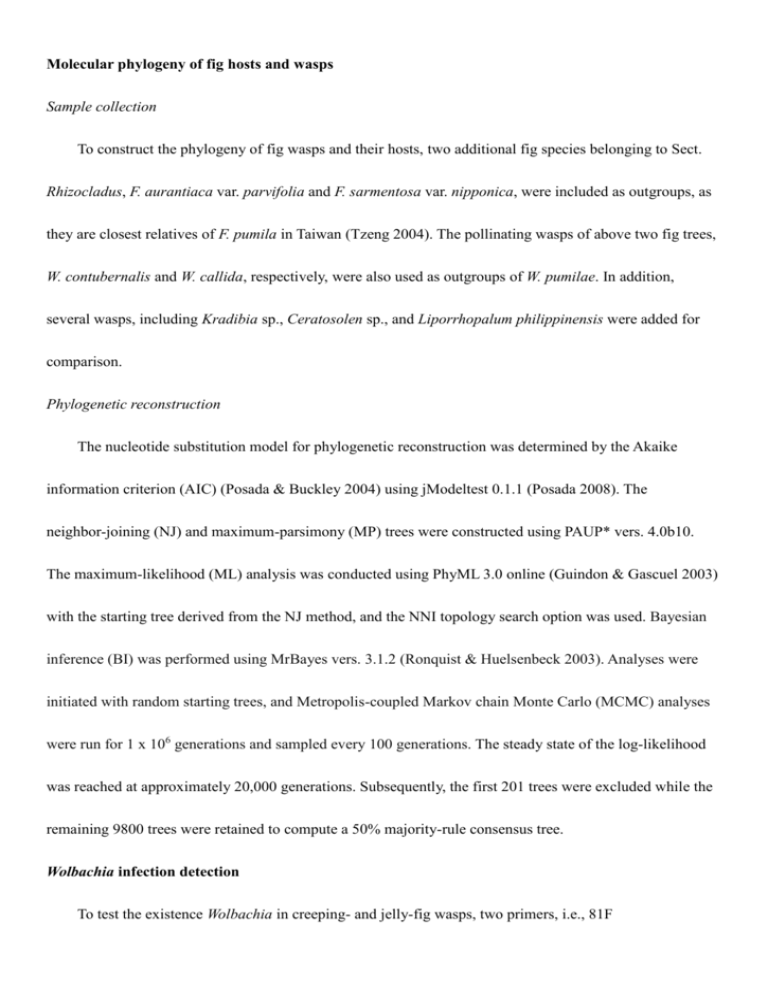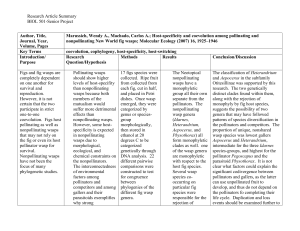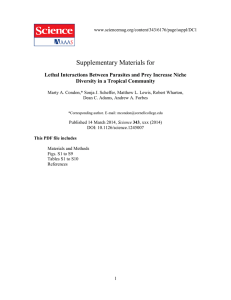mec12336-sup-0003-AppendixS2
advertisement

Molecular phylogeny of fig hosts and wasps Sample collection To construct the phylogeny of fig wasps and their hosts, two additional fig species belonging to Sect. Rhizocladus, F. aurantiaca var. parvifolia and F. sarmentosa var. nipponica, were included as outgroups, as they are closest relatives of F. pumila in Taiwan (Tzeng 2004). The pollinating wasps of above two fig trees, W. contubernalis and W. callida, respectively, were also used as outgroups of W. pumilae. In addition, several wasps, including Kradibia sp., Ceratosolen sp., and Liporrhopalum philippinensis were added for comparison. Phylogenetic reconstruction The nucleotide substitution model for phylogenetic reconstruction was determined by the Akaike information criterion (AIC) (Posada & Buckley 2004) using jModeltest 0.1.1 (Posada 2008). The neighbor-joining (NJ) and maximum-parsimony (MP) trees were constructed using PAUP* vers. 4.0b10. The maximum-likelihood (ML) analysis was conducted using PhyML 3.0 online (Guindon & Gascuel 2003) with the starting tree derived from the NJ method, and the NNI topology search option was used. Bayesian inference (BI) was performed using MrBayes vers. 3.1.2 (Ronquist & Huelsenbeck 2003). Analyses were initiated with random starting trees, and Metropolis-coupled Markov chain Monte Carlo (MCMC) analyses were run for 1 x 106 generations and sampled every 100 generations. The steady state of the log-likelihood was reached at approximately 20,000 generations. Subsequently, the first 201 trees were excluded while the remaining 9800 trees were retained to compute a 50% majority-rule consensus tree. Wolbachia infection detection To test the existence Wolbachia in creeping- and jelly-fig wasps, two primers, i.e., 81F (TGGTCCAATAAGTGATGAAGAAAC) and 691R (AAAAATTAAACGCTACTCCA) (Braig et al. 1998; Xiao et al. 2012; Zhou et al. 1998), which are commonly used to amplify Wolbachia surface protein gene (wsp) was applied. Twenty-seven individuals from nine creeping-fig wasp populations and 15 individuals from five jelly-fig wasp populations were tested. The Wolbachia-infected Aedes albopictus mosquito and uninfected A. aegypyi were included as a positive and negative control, respectively. Wolbachia was not detected in any wasp tested and was only found from the positive control of A. albopictus mosquito and the amplify fragment was approximate 600 bp. Consequently, mitochondrial divergence between the two fig wasps was not influenced by Wolbachia. Braig HR, Zhou W, Dobson SL, O'Neill SL (1998) Cloning and characterization of a gene encoding the major surface protein of the bacterial endosymbiont Wolbachia pipientis. Journal of Bacteriology, 180, 2373-2378. Guindon S, Gascuel O (2003) A simple, fast, and accurate algorithm to estimate large phylogenies by maximum likelihood. Systematic Biology, 52, 696-704. Posada D (2008) jModelTest: phylogenetic model averaging. Molecular Biology and Evolution, 25, 1253-1256. Posada D, Buckley TR (2004) Model selection and model averaging in phylogenetics: advantages of Akaike Information Criterion and Bayesian approaches over likelihood ratio tests. Systematic Biology, 53, 793-808. Ronquist F, Huelsenbeck JP (2003) MrBayes 3: Bayesian phylogenetic inference under mixed models. Bioinformatics 19, 1572-1574. Tzeng HY (2004) Taxonomic study of the genus Ficus in Taiwan, Ph.D. Thesis, National Chung Hsing University. Xiao J-H, Wang N-X, Murphy RW, et al. (2012) Wolbachia infection and dramatic intraspecific mitochondrial DNA divergence in a fig wasp. Evolution, 66, 1907-1916. Zhou W, Rousset F, O'Neill S (1998) Phylogeny and PCR-based classification of Wolbachia strains using wsp gene sequences. Proceedings of the Royal Society of London Series B Biological Sciences, 265, 509-515. Fig. S1 The Neighbor-joining (NJ) tree of fig wasps corrected by the HKY+G (0.34) model based on the first intron of elongation factor (EF1-i1) sequence. Numbers above the branches, from top to bottom, are statistical supports derived from maximum likelihood, Bayesian, Neighbor-joining, and maximum parsimony methods, respectively. Fig. S2 Alignment of partial wingless coding sequences and their one-letter amino acid translation of creeping and jelly fig wasps. Dots represent identical nucleotides. There was no variation within the respective creeping and jelly fig wasp populations. Only one G-T synonymous change at position 99 distinguished creeping and jelly fig wasps. Fig. S3 Historical demographics of the jelly-fig wasps inferred from the first intron of elongation factor 1 (EF1-i1) by the Bayesian skyline plot. The X-axis is years before the present, and the Y-axis is the product of the effective population size (Ne) and generation time (τ) in years. The black line represents median estimates and the gray lines represent 95% highest posterior densities. Fig. S4 The Neighbor-joining (NJ) tree of different wasp populations, Wiebesia pumilae, based on genetic distances derived from 12 microsatellite loci. Sample abbreviations are as shown in Fig. 1. CKS-1 and -2 are wasps derived from the syconia of creeping-fig trees, but their genetic compositions are close to the rest of the creeping- and jelly-fig wasps, respectively. Numbers on the branches are from 1000 bootstrap replications. Fig. S5 Phylogenetic trees of fig plants based on (A) chloroplast trnT-trnL (trnT-trnL), (B) ribosomal intergenic spacer-I (ITS1), and (C) the third intron of the nitrate reductase gene (NIA-i3). Black triangles are sequences of jelly figs, and white triangles represent sequences of creeping figs. Numbers close to the branches, from top to bottom, are statistical support derived from the maximum-likelihood, Bayesian, Neighbor-joining, and maximum-parsimony methods, respectively. For (C), only bootstrap values of the Neighbor-joining method are presented. Fig. S6 Genetic clusters of fig trees, Ficus pumila, inferred by Bayesian methods simulated for individual multilocus genotypes.







